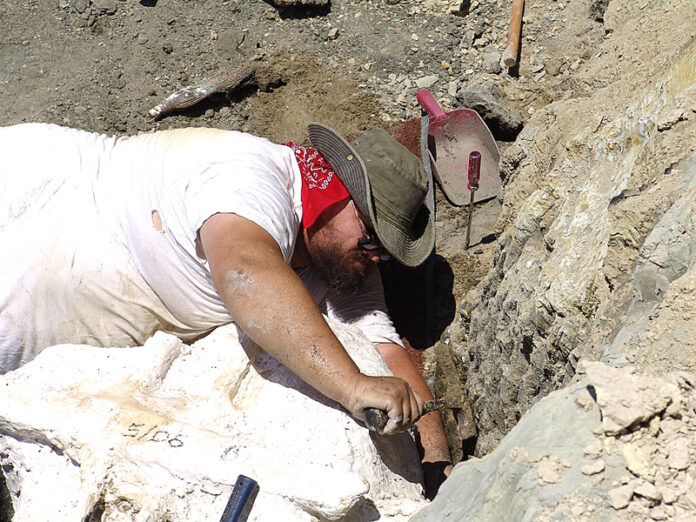
Dr. Alton Dooley, curator of paleontology at the Virginia Museum of Natural History, has spent the majority of his career excavating Virginia’s Carmel Church Quarry in Caroline County and is now seeking public support to continue excavating one of the world’s most important fossil sites before high erosion rates and possible development cause the fossils to be lost forever.
Carmel Church is one of the richest fossil deposits in eastern North America and has yielded a vast diversity of marine fossils from the Miocene era, a time period between 5 million and 23 million years ago. The fossils discovered at the site include a variety of animals, including whales, sharks, fish, turtles, crocodiles, seals and sea cows and more. It is also one of few sites along the Atlantic Coast that has produced land mammals from this time period.
While the rich marine and mammal fossil variety that the Carmel Church site boasts is uncommon, what separates Carmel Church from any other excavation site is the high density of bones found there, according to Dooley.
“At Carmel Church, whale skeletons are literally lying on top of one another,” said Dooley. “The high bone density is the focus of my research here at the museum. What makes Carmel Church so special that it should have a bone density that is orders of magnitude higher than other localities on the east coast? We hope to answer that question by preserving and documenting the fossils.”
Doing so, however, requires funding that is available from limited resources, which researchers across the nation compete to obtain.
To help fund future excavations and field work at the site, Dooley is looking at crowd-funding as an alternative. Instead of relying mainly on grants from government and private entities, he is now able to provide a simpler way for individuals who wish to help through a new Web site called Petridish, a donation Web site developed by members of the scientific community to help advance science through research and discovery. Scientists apply and have to meet certain criteria in order to have their research projects listed.
“We’ve always relied on public support to carry out the excavations at Carmel Church,” said Dooley. “However, many people have expressed an interest in helping, but have found the scale of our projects daunting. Petridish provides a way for anyone interested in paleontology to be a part of the exciting science going on at Carmel Church.”
Beginning April 9, Dr. Dooley’s upcoming expedition, “Saving fossil whales in Virginia”, is featured on the Petridish Web site at petridish.org. The expedition is scheduled to take place in late summer or early fall of 2012.
Individuals can pledge as little as $1 or as much as $2,000 or more, with each pledge earning individuals rewards based on the amount pledged. Rewards range from recognition on Dr. Dooley’s research blog, to posters, baseball caps, and cast replicas of fossils found at Carmel Church. Pledges of $2,000 or more earn an individual a spot on the excavation team.
“The funding we receive will allow us to fund an excavation team of 5 people for a two week excavation at Carmel Church, including all of our excavation supplies,” said Dooley. “We will also be able to purchase lab supplies, such as adhesives and consolidates to help repair and preserve the bones and casting materials for making replicas of certain specimens for exhibits and educational programs. We also post daily blog updates about our excavations, and encourage schools and others to follow our progress as we make our discoveries.”
The goal of the campaign is to raise $4,000 over a 60 day period. If the money pledged falls short of the amount, all pledges will be void. However, Dooley notes that if the pledges exceed the goal, it’s possible enough funding would be available to extend the excavation longer than the two week period.
“While we are seeking funds for at least two weeks, with sufficient funding we can extend the excavation for an additional week or more,” said Dooley. “Past excavations suggest that we should be able to collect approximately one ton of material over three weeks, representing more than 1000 bones and teeth.”
According to Dooley excavating Carmel Church is becoming extremely important due to the growing uncertainty of its future.
“It is rare for a vertebrate paleontologist to excavate a site with a 100% certainty of recovering fossils,” said Dooley. “Carmel Church is just such a site, giving us a very high data return on investment. However, the site is at risk due to high erosion rates and possible future development. We are attempting to save as many fossils as we can before they’re lost forever.”
To learn more about supporting Dr. Dooley’s expedition, visit www.petridish.org. To learn more about the museum’s scientific research and collections, or to visit Dr. Dooley’s blog, visit www.vmnh.net.


